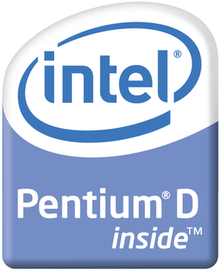Pentium D
 |
|
| Produced | From 2005 to 2008 |
|---|---|
| Common manufacturer(s) |
|
| Max. CPU clock rate | 2.66 GHz to 3.73 GHz |
| FSB speeds | 533 MT/s to 1,066 MT/s |
| Min. feature size | 90 nm to 65 nm |
| Instruction set | MMX, SSE, SSE2, SSE3, and x86-64 |
| Microarchitecture | NetBurst |
| Cores | 2 (2×1) |
| Socket(s) | |
| Predecessor | Pentium 4 |
| Successor | Pentium Dual-Core, Core 2 |
| Core name(s) |
|
The Pentium D brand refers to two series of desktop dual-core 64-bit x86-64 microprocessors with the NetBurst microarchitecture, which is the dual-core variant of Pentium 4 "Prescott" manufactured by Intel. Each CPU comprised two dies, each containing a single core, residing next to each other on a multi-chip module package. The brand's first processor, codenamed Smithfield, was released by Intel on May 25, 2005. Nine months later, Intel introduced its successor, codenamed Presler, but without offering significant upgrades in design, still resulting in relatively high power consumption. By 2004, the NetBurst processors reached a clock speed barrier at 3.8 GHz due to a thermal (and power) limit exemplified by the Presler's 130 watt thermal design power (a higher TDP requires additional cooling that can be prohibitively noisy or expensive). The future belonged to more energy efficient and slower clocked dual-core CPUs on a single die instead of two. The final shipment date of the dual die Presler chips was August 8, 2008, which marked the end of the Pentium D brand and also the NetBurst microarchitecture.
The dual-core CPU is capable of running multi-threaded applications typical in transcoding of audio and video, compressing, photo and video editing and rendering, and ray-tracing. Single-threaded applications, including most older games, do not benefit much from a second core compared to an equally clocked single-core CPU. Nevertheless, the dual-core CPU is useful to run both the client and server processes of a game without noticeable lag in either thread, as each instance could be running on a different core. Furthermore, multi-threaded games benefit from dual-core CPUs.
...
Wikipedia
